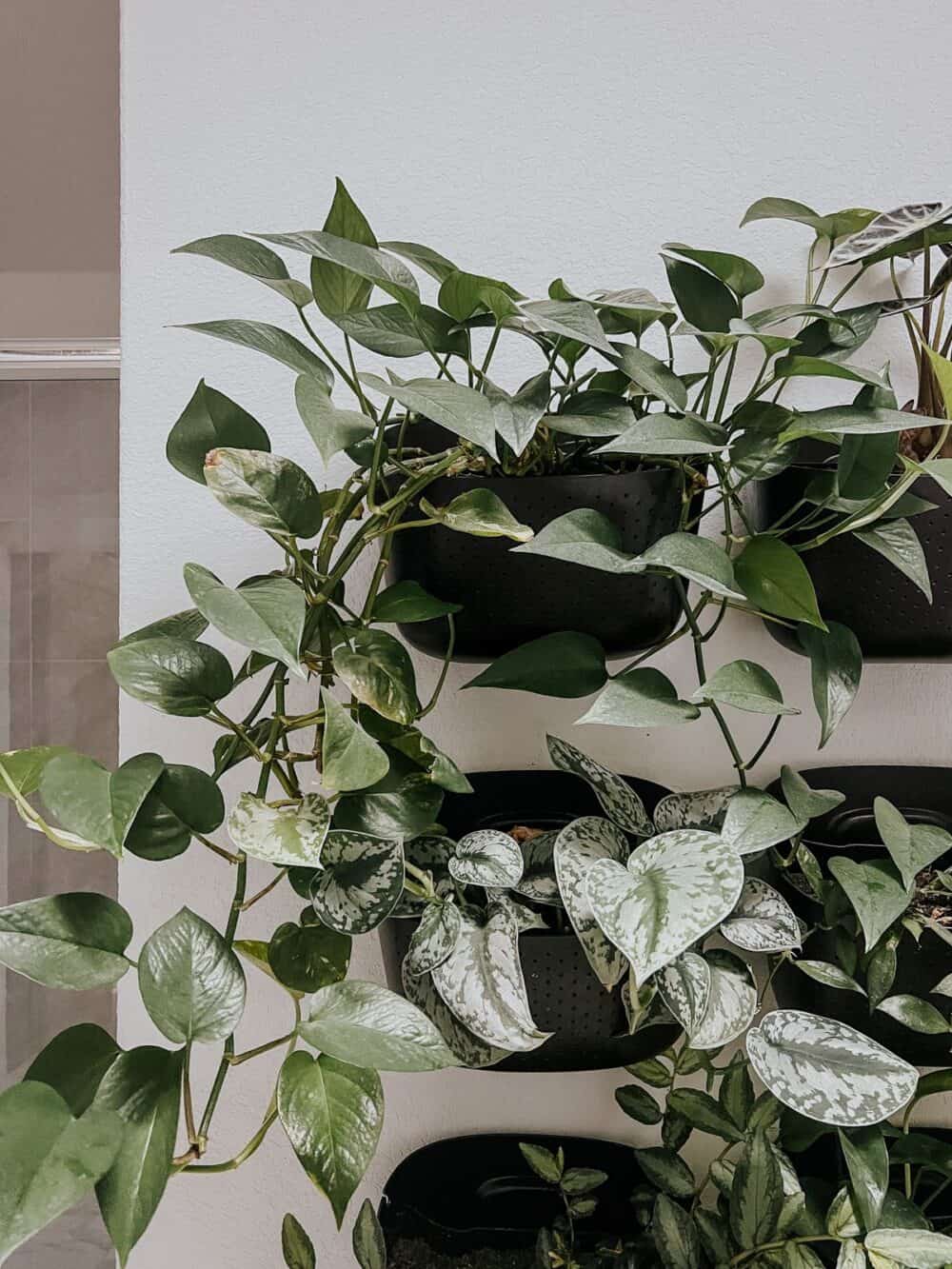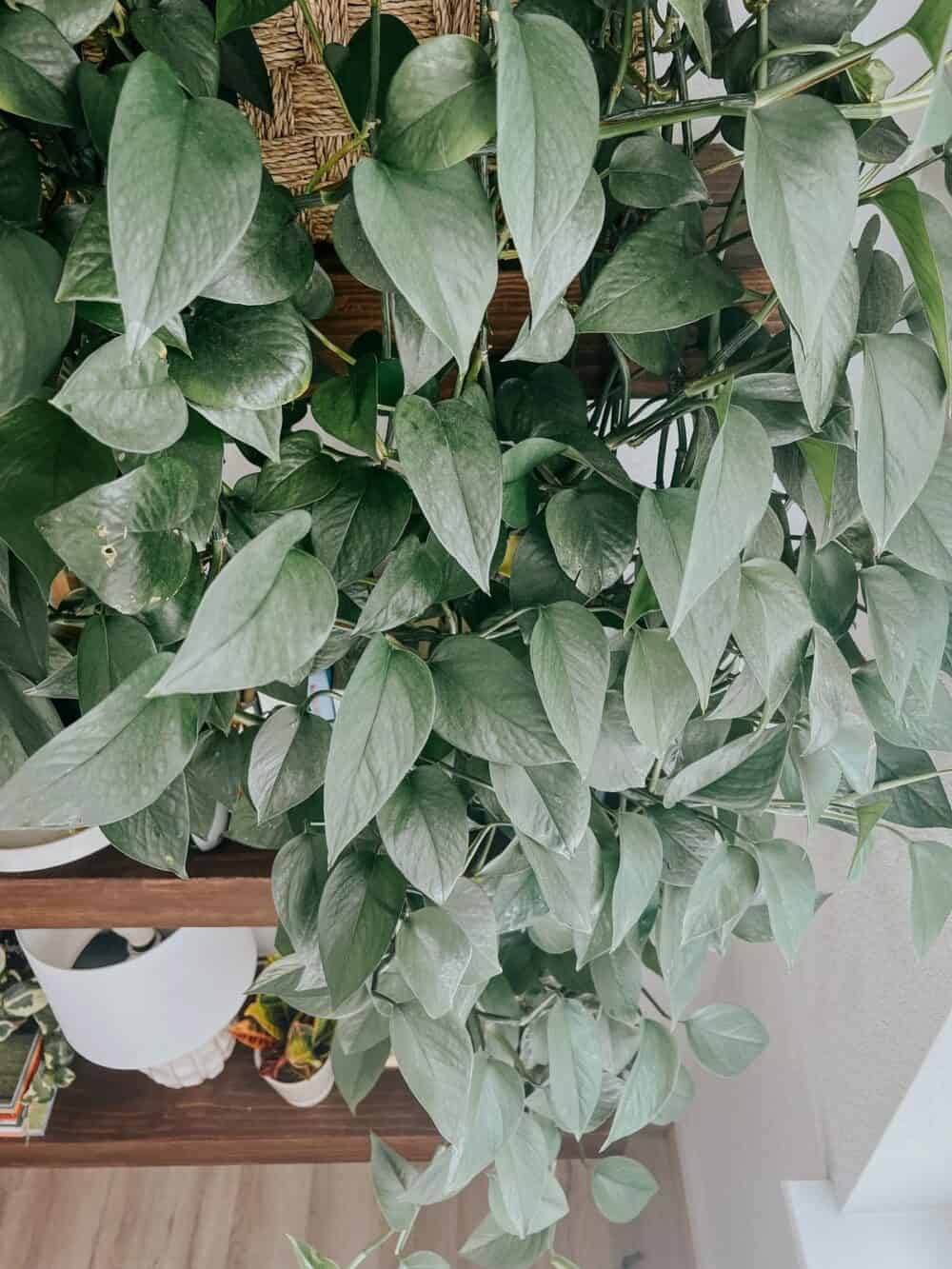Pothos Plant Care: Tips & Tricks
What’s your favorite houseplant? Mine is, by far, the pothos. It’s a humble little plant that you’ll find in many offices, dentist’s lobbies, and grandmother’s homes. It’s not hip or cool like a Monstera or a Fiddle Leaf Fig. Some might call it downright boring. But not me. Pothos are my favorite because they’re so easy to care for, so beautiful, and so satisfying to watch grow! I get questions about our giant pothos in our living room all the time, so it’s high time we did a deep dive on pothos plant care to help you get started with a pothos plant of your own.

Our plant wall with a Jade Pothos and a Satin Pothos
Epipremnum aureum (common name, Pothos) is widely considered to be one of the easiest houseplants around to care for. It’s a trailing vine native to the Solomon Islands in the South Pacific. If it’s being planted outside, it’s good for hardiness zones 10-12.
Also known as Devil’s Ivy, the Pothos has really flexible light needs, it doesn’t need to be watered often, and it survives a lot of neglect. It’s a vine, so it can trail down off a shelf or be trained to grow up a trellis. Pothos plants have glossy green leaves, and they do not flower. They’re really great for the air in your home, and are really efficient at removing indoor pollutants like formaldehyde, xylene, and benzene from the air.
There are also lots of variations of pothos, like the Neon Pothos, Jade Pothos, and the Marble. Queen Pothos. They’ve all got different leaf patterns and colors, and they’re all beautiful in their own unique way. We’ll get into all of those in a minute – first, let’s start with the basics!
Pothos Care
Pothos plants may be really easy to take care of, but any plant will struggle if it doesn’t have the right conditions! Here’s a quick look at everything you need to know about how to take care of Pothos plants.

Light Needs
Pothos do best in bright, indirect sunlight. I have my big one sitting on a tall shelf in my living room where it’s exposed to bright, indirect light all day long. It gets a tiny amount of direct light first thing in the morning, but that’s it. This is the sweet spot for Pothos plants – they love to be in a really sunny room, but they don’t need to be in a window or directly exposed to the sunlight.
Pothos can also survive in more low-light conditions. That’s why you’ll often find them in dimly lit office buildings! Without as much sunlight, a Pothos plant won’t grow nearly as quickly or be quite as healthy. But, it’ll do just fine in a room with minimal sunlight.
The one light condition Pothos plants don’t like is direct sunlight. If exposed to too much direct sun, their leaves will burn and turn brown.
It’s also worth noting that variegated Pothos who aren’t exposed to enough light may lose some of their white color and variegation.
Watering Needs
How often should you water your Pothos plant? That depends – there isn’t ever a one-size-fits-all formula for watering any plant. It will always depend on the environment of your home and the specific location of the plant. That being said, Pothos are really tolerant of most watering conditions and it’s pretty hard to mess it up!
I water my Pothos once a week. I water deeply, and I have it in a planter with a drainage hole so I don’t need to worry about any water settling in the bottom of the pot and causing root rot. You should allow the soil to dry out fully before watering your Pothos. If you are new to plants, I highly suggest using a moisture meter to help you keep an eye on things!
If you notice black spots on your Pothos’ leaves, or if you start to see a lot of yellow leaves, that’s a good sign that you might be overwatering. Conversely, if you notice the leaves begin to curl up, that’s an indication that it’s thirsty! I recommend closely watching your plant for your first few months with it and you’ll quickly begin to learn how it communicates its needs with you. When the leaves are green, glossy, and perky, your plant is happy!

Soil
Pothos plants aren’t picky about soil at all. They do great in regular, well-draining potting mix and they don’t need a specialty potting soil. If you’d like to increase the drainage in your soil, you can mix in some perlite or lava rocks, but it’s not necessary!
Temperature & Humidity
Again, this is an area where the Pothos plant isn’t too picky. They’ll do just fine in a variety of situations. But, they are a tropical plant and will really thrive when they’re in a space with high humidity. They’ll be happiest in a room kept between 65-75 degrees Fahrenheit, and generally should be kept above 50 degrees Fahrenheit. They can hang in hotter temperatures (I’ve kept one outside in the Texas summer!), but may need to be watered more frequently.
Other
Just like any plant, pests and insects can be a problem for your Pothos. If you start to notice small fungus gnats flying around your plant, I recommend treating with Neem Oil spray for a few weeks. For us, that always cuts it right out!
Mealybugs are also a relatively common pest for Pothos – they can be handled with a thorough cleaning an insecticidal soap, or with an alcohol-soaked cotton swab.
Different Types of Pothos
There are a lot of cultivars of pothos plants – and I’ve gathered quite a few of them in my own home. Here’s a quick look at some of the most popular variations.
Golden Pothos
This is what most of us think of when we picture a Pothos plant. Their foliage is slightly heart-shaped and is green with some golden variegation. It’s a great climber, and can also trail down off a tall shelf.
Neon Pothos

This cultivar has really bright, chartreuse leaves. It needs less light than the standard Pothos, and is really great in a hanging planter in a darker corner of your home. If it doesn’t get enough light, it will lose some of its bright color – these guys will stay more “neon” in bright, indirect light. I’ve got one in our kitchen and one in Jackson’s room!
Jade Pothos
The Jade Pothos is very similar to the Golden Pothos – and the two often get confused. The best way to tell the difference is that the Jade Pothos has fully green leaves, whereas the Golden Pothos will have some yellow variegation on their leaves.
Marble Queen Pothos
This Pothos plant has darker green heart-shaped leaves that are streaked with white. It prefers brighter light situations (though, still no direct sun!), and is slower to grow.
Silver Satin Pothos

This plant has thick, gray-green leaves with silver splotches. It’s very tolerant of low light and drought conditions. It’s technically not actually a Pothos – it’s kind of like a Pothos’ cousin! But, it often gets lumped in with other Pothos varietals because they’re so similar.
Pothos Njoy
This plant has green leaves with a heavy, creamy white variegation pattern. The leaves are smaller than most other pothos plants.
There are lots of other varieties of Pothos plants, but these are the ones you’ll see most often!
Propagating Pothos Plants
Propagating pothos is incredibly easy. I’ve got a full blog post with a breakdown of how to propagate Pothos if you want a deep dive, but here’s a quick overview:
- Use scissors to cut off a section of the vine right above a leave node.
- Pull off the leaves from the bottom section of what you’ve cut. You want to have at least one empty leaf node to go in the water.
- Stick the stem cuttings in a jar of water, making sure the place where you pulled a leaf off is submerged.
- Allow a few weeks for the cutting to grow new roots. Change out the water if it starts to look cloudy. Once the plant has grown roots that are a few inches long, you’re ready to transplant it to some fresh potting soil!
FAQs About Pothos
How Big Does a Pothos Get?
Pothos are also called a “Devil’s Vine” because they’re just that – a vining plant! If given something to climb up and a little help, they can grow really tall. When allowed to trail….well, you’ve seen how long my Pothos gets.

On our plant shelf, you can see a large Jade Pothos and a Pothos NJoy on the bottom left shelf!
It’s worth noting that, generally speaking, vining plants do best when allowed to grow up rather than down. They can get bigger and their leaves stay healthier. But, a gorgeous vine in a hanging basket or up on a tall shelf is hard to resist, and they do fine that way too!
Pothos plants grow really quickly and can grow up to a foot a month! In the wild, they’ll grow up to 60 feet long. In household settings, though, they generally end up around 6-10 feet long.
You’ll notice that on my large Pothos, some of the leaves near the top are yellowing on the edges. This is normal for a really large plant. As it produces more leaves, the older ones don’t get as much energy and can die off. Really old Pothos plants can start to lose older leaves and look really leggy for this reason! I often propagate my Pothos and re-plant the cuttings up at the top to help combat this.
Are Pothos Safe for Pets?
Like many houseplants, Pothos are toxic to pets and humans. If ingested, it can cause vomiting and irritation due to the calcium oxalates in the plant, which acts as a contact irritant, especially around the lips and mouth. So, keep your Pothos away from curious pets and kids and you should be fine!
And that, my friends, is everything you could possibly need to know about how to care for a Pothos plant.

